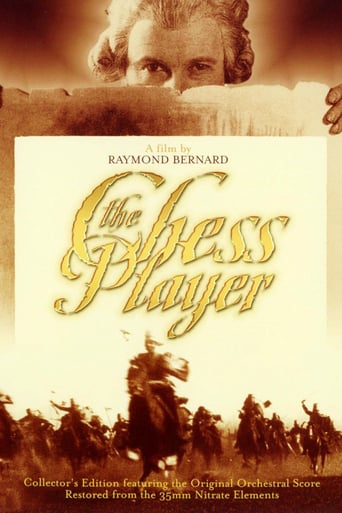anches-725-976306
This French film starts very intriguingly with some hand-held camera work and a story which promises great things but, sadly, it loses its way. The story becomes so confusing that I suspect that mine is not the full version-avenues are opened and not explored, while others are explored without, apparently, being opened. I apologise if the following constitutes "spoilers" but why does Oblomov's manservant dress as a woman?, how does Wanda know she has betrayed Boleslas? and how long can a man with both legs broken be hidden inside an automaton, carted hither and yon and left outside in the snow overnight without suffering fatal consequences? Setting aside these quibbles, this is a fascinating effort and in its time and shown on the big screen I can imagine it was a hit, the scenes involving the automata being especially interesting.
canscene
"Game Over: Kasparov and the Machine" is a new feature length documentary from famed British film maker Vikram Jayanti. Seen at the 2003 Toronto International Film Festival , it documents the 1997 match between Garry Kasparov arguably the greatest chess player ever and IBM's Deep Blue. The computer won, but subtly the film slyly hints at the possibility that a human mind might have been behind Deep Blue, throwing Kasparov off balance. The Kasparov narrative is interspersed with clips from The Chess Player, although I did not notice any verbal credits in Game Over's narration to that 1927 film.This inclusion was particularly interestng to me, since I saw the original silent film as a boy and remembered vividly how Major Nicolaieff, invading von Kempelen's workshop is hacked to death by the inventor's "bodyguard" of sabre wielding automatons. The Milestone DVD is most certainly the longer version mentioned by a previous commentator on this site. THe DVD also carries a recent radio interview with the author of "The Turk" which deals with the real Wolfgang Von Kempelen and his remarkable chess playing automaton. URTL is <theTurkbook.com?> The movie is undeed slightly confusing, but to movie buffs well worth a viewing for the striking action cinematography wwith tinted footage ranging from black and white to blue of night.
zetes
Divided into two parts, the first half is okay, if generally unremarkable. It concerns a group of Polish people rebelling against the Russians, who are dominating them. The second half is mostly painful to sit through. The leader of the Polish rebels, Boleslas (Pierre Blanchar), is disguised as an undefeatable robotic chess player, designed by Baron von Kempelen (Charles Dullin), who is famous for his automatons. When the automaton faces the Empress of Russia, Catherine II, she cheats to see what her opponent will do. He responds by swiping the pieces off the chess board. The Empress finds it amusing, but orders the automaton to be shot. The film is way overlong (imdb lists under 90 minutes, but the Milestone DVD runs 139), and the story and themes are convoluted. Like a lot of overambitious silent films, its far too many characters are easy to confuse. I was quite bored through the film. There were several great moments, though. The battle scenes in the first half are exceptional. Bernard uses some sort of handheld camera to make it seem like the viewer is in the battle. It's a common technique nowadays, but I can't recall seeing it earlier than 1927. This has to be at least one of the first times when this was done. The cinematography is generally good, and often great, especially in the first half. Although the second half is hard to sit through, there is an extended sequence where one character is caught in the middle of a group of Baron von Kempelen's automaton soldiers. I didn't even really know who this character was exactly, but it was a neat scene.
david melville
Comparable to Abel Gance's Napoleon in its scale and stylistic bravura, this romantic epic about the Polish nobility's 1776 uprising against Catherine the Great differs from the more famous film in its lack of nationalist fervour and Tricolour bombast. Its one 'rousing battle scene' is a pure fantasy, a daydream of its naive heroine as she thumps out a patriotic hymn on her piano. This dream sequence is daringly intercut with the actual battle - a fiasco whose leaders are killed and maimed, bringing no glory to either Russian imperialists or Polish rebels.In place of Boys Own heroics, director Raymond Bernard conjures up an eerily perverse atmosphere of ETA Hoffman-style Gothic Expressionism. The young hero's 'protector', the Baron von Kempelen, is based on a real-life inventor who stunned the courts of Europe with his life-size mechanical dolls. On the run after his abortive revolution, young Boleslav is disguised by the Baron as a chess-playing robot - not a man, but a mechanical image of one. He finds his true self, not on the battlefield, but in the wholly unreal world of chess. His sister Sophie becomes an icon of Polish liberation, not in person, but as a woven banner. Her forbidden love for a Russian officer is consummated, not in the flesh, but in a portrait he paints of her.In short, Bernard is a film-maker in thrall to illusion - and to the inherently unreal nature of the cinematic image. At the film's climax, not one but two artificial worlds fight it out for control of the screen. A sumptuous masked ball at the Imperial Court, and the villain's showdown with Baron von Kempelen's army of automatons. History, or so Bernard seems to be saying, is not a fact but an illusion, a masquerade, a war of manufactured images that its leaders manipulate for their own ends. Heroism has nothing to do with it.David Melville



